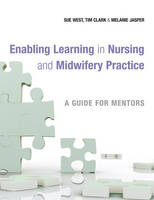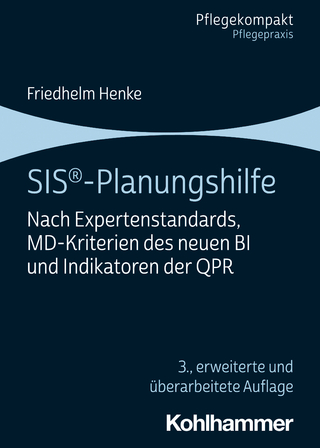
Enabling Learning in Nursing and Midwifery Practice
John Wiley & Sons Inc (Verlag)
978-0-470-05797-1 (ISBN)
With current Government targets to increase health and social care practitioners, there is an increased need for informed mentors and preceptors to support the development of the students and new health professionals.
Enabling learning in nursing and midwifery practice: A guide for mentorsseeks to underpin recent mentoring initiatives, exploring the impact of mentoring, supervision and preceptorship on professional practice, covering principles that underpin effective learning and providing practical guidance on mentoring and assessment strategies within practice settings.
Enabling learning in nursing and midwifery practice: A guide for mentorsaddresses the inter-professional and policy context for mentorship, examines the nature of effective learning environments and provides mentors with the necessary tools to assist students in their development within a practice setting. It explores the use of reflective practice, virtual learning and other core resources to enhance and support learning in practice and addresses assessing practice, making correct judgements about student competence and the development of competence in newly qualified practitioners.
Enabling learning in nursing and midwifery practice: A guide for mentorsis an important resource text for practitioners seeking to support learning in practice as well as experienced mentors and preceptors seeking to update their skills and understanding.
Key features
* Evidence-based, practical guide to effective mentoring and preceptorship
* Integrates theory and practice
* Addresses the context of learning in practice and the challenges of clinical supervision
* Promotes understanding of the importance of assessing practice and managing the mentoring process
* Equips mentors to enable students and newly qualified staff to gain confidence and expertise
* Includes activities, points for reflection and examples from practice
Sue West is Senior Lecturer in Adult Nursing at Canterbury Christ Church University. Professor Melanie Jasper is Head of School of Health Science, University of Wales Swansea. Dr Tim Clark is Senior Lecturer in Nursing and Applied Clinical Studies at Canterbury Christ Church University.
Preface. Introduction.
1 CONTEMPORARY ISSUES IN MENTORING PRACTICE (Margaret Andrews).
Introduction.
The Practice Context.
Chapter Summary.
References.
2 A GOOD PLACEMENT EXPERIENCE: THE STUDENT’S PERSPECTIVE OF THEIR NEEDS IN THE PRACTICE SETTING (Sue West).
Introduction.
Clarifying the Context: Learning as Input, Process and Outcome.
Input: An Effective Structure for the Placement Learning Experience.
Process: Some of the Variables within the Learning Experience.
Output: The End Result of the Learning Experience.
Chapter Summary.
References.
3 THE REFLECTIVE MENTOR: FACILITATING LEARNING IN THE PRACTICE SETTING (Melanie Jasper).
Introduction.
Being a Refl ective Mentor.
Practice as a Learning Environment.
Maximizing Your Own Opportunities for Development.
Chapter Summary.
References.
4 HELPING PEOPLE LEARN (Stevie Penfold).
Introduction.
Everyday Teaching and Learning.
Behaviourist Theory.
Social Learning Theory.
Cognitive approaches to helping learners.
Constructing Learning.
Application of Knowledge for Practice.
Practical Tips for Teaching and Facilitating Learning.
Chapter Summary.
References.
5 DEVELOPING EFFECTIVE LEARNING RELATIONSHIPS IN PRACTICE (Sheila Daykin).
The Effective Mentor.
Facilitation.
Dysfunctional Mentor–Learner Relationships.
Chapter Summary.
References.
6 LEARNING STYLES IN PRACTICE (Tim Clark).
Introduction.
Clarifying the Context: What Are Learning Styles?
Learning Styles – Which One Are You?
Processing Information.
Questionnaires That Examine Learning Style.
Chapter Summary.
References.
7 USING INTERPERSONAL SKILLS IN MENTORING (Sue Riddell).
Introduction.
Phases of the Relationship.
Attending and Listening.
Questioning.
Responding.
Feedback.
Chapter Summary.
References.
8 THE LEARNING ENVIRONMENT (Gill Beer and Andrew Southgate).
Introduction.
Method of Learner Allocation.
Clinical Staff.
Nature of the Learner.
Higher Education Institutions.
Clinical Environment.
Chapter Summary.
References.
9 THE DEVELOPMENT OF COMPETENCE IN NEW QUALIFIED PRACTITIONERS (Tim Clark).
Introduction.
What is Competent Practice?
Preceptorship.
What Are the Key Features?
Adopting a ‘Cloak of Competence’.
Chapter Summary.
References.
10 ASSESSMENT OF PRACTICE: PRINCIPLES, PROCESS AND RESPONSIBILITIES (Sue West).
Introduction.
The Journey to Professional Practice.
The Purpose of Assessment.
Underpinning Principles.
Assessment Criteria.
Single Event Versus Continuous Assessment.
Factors That Infl uence Assessment in Practice.
Becoming Student-Centred.
Making a Decision.
Managing the Failing Student.
Chapter Summary.
References.
11 USE OF THE INTERNET TO SUPPORT LEARNING IN PRACTICE (Susan Westerman and Emily Hurt).
Introduction.
Use of the Internet and Other New Technologies in the Higher Education and Health-care Sectors.
Some Potential Benefi ts and Challenges of Using the Internet to Support Learning in Practice.
Some Practical Applications and Illustrations of the Internet Supporting Practice-Based Learning.
Key Health-care Online Resources.
The Internet Supporting Communication, Interaction and Refl ection.
How to Manage All This Information.
Chapter Summary .
References.
12 CHALLENGES IN THE INTERPROFESSIONAL AGENDA (Judith Parsons).
Introduction.
Why an Interprofessional Approach?
A Shared Vision.
Skills in Interprofessional Facilitation of Learning.
Moving Forward.
Chapter Summary.
References.
13 WORKING AS A PROFESSIONAL: STANDARDS FOR PROFESSIONAL PRACTICE (Melanie Jasper).
Introduction.
Mentors as Professional Practitioners.
Standards for Mentoring.
Your Role as a Mentor.
Maintaining Your Professional Competence.
Chapter Summary.
References.
Glossary of Terms.
Index.
| Erscheint lt. Verlag | 28.2.2008 |
|---|---|
| Verlagsort | New York |
| Sprache | englisch |
| Maße | 191 x 239 mm |
| Gewicht | 510 g |
| Themenwelt | Medizin / Pharmazie ► Pflege |
| ISBN-10 | 0-470-05797-1 / 0470057971 |
| ISBN-13 | 978-0-470-05797-1 / 9780470057971 |
| Zustand | Neuware |
| Haben Sie eine Frage zum Produkt? |
aus dem Bereich


